 Amphibious Transport Docks Built 1985-1994:
Amphibious Transport Docks Built 1985-1994:San Giorgio, San Marco, San Giusto (L9892 to 9894).
Exports: Kalaat Béni Abbès, Al Fulk.
San Giorgio class LSDs: For the Italy Unity Day, let’s review the largest amphibious ships ever designed for the Italian Navy, a far cry from the WW2 Motozaterra MZ, they actually replaced much older De Soto county class ships, Grado and Caorle, and will be replaced in the 2030s by the LxD-project. These vessels were studied at the end of the 1980s as the first Italian-designed and built amphibious transport docks (LPD), ordered to Fincantieri, and able to carry a battalion and or in alternative up to 36 armored vehicles. It had a stern floodable dock for three landing craft and a flight deck, but no hangar, still operating four helicopters. They are today based at Brindisi, San Giusto featuring an improved design and used to train crews for the others. In addition two more were exported: One for Algeria and one for Qatar. #coldwar #marinemilitare #italiannavy #italiannanvy #unityday #sanmarco #sangiusto #sangiorgio.
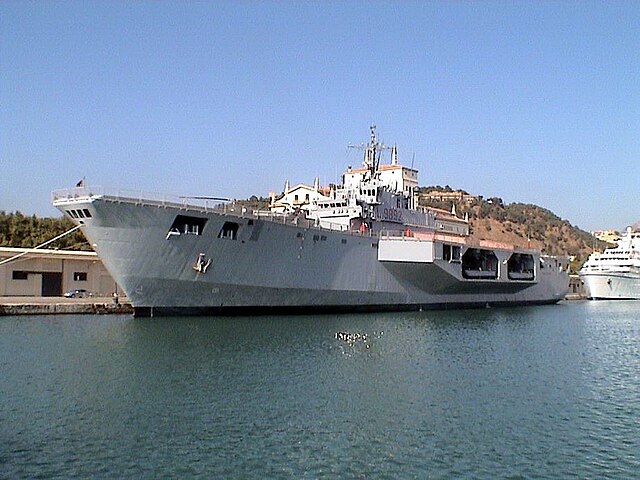
San Giorgio after refit and modernization, full bow deck.
Development
The San Giorgio class, also known as the “Saints class” of Landing Platform Dock (LPD) for amphibious warships warfare were designed to replace much older vessels. They were to succeed to the Grado class, decommissioned at the end of the 1980s. They were to constitute the bulk of the modernized “Sea Projection Force”, the amphibious component of the Italian Armed Forces. To make a rapid brush-like portait of Amphibious assets of the Marina Militare during the cold war, the early 1950 to 1981 counted on 14 MFP-D built in Germany and Italy, a WW2 design, added to ten LCT(3) ex-RN, 20 LCMs, 30 LCVPs and 6 LSSL under MDAP. They were kept until the 1980s, waiting for a new generation, the 1967 Quarto class Landing Ships (three built). But the latter were seen largely as a failure, and were axed in the 1968 budget cuts. Instead, were purchased ex-US De Soto Country LSTs, very capable and large vessels, purchased in 1981 as Grado and Caorle.
The De Soto class however were 1950s tech vessels, and lacked a flight deck or dock, they were glorified, large (7,823 long tons full load) WW2 LSTs essentially, carrying 28 medium tanks or vehicles and up to 580 troops.
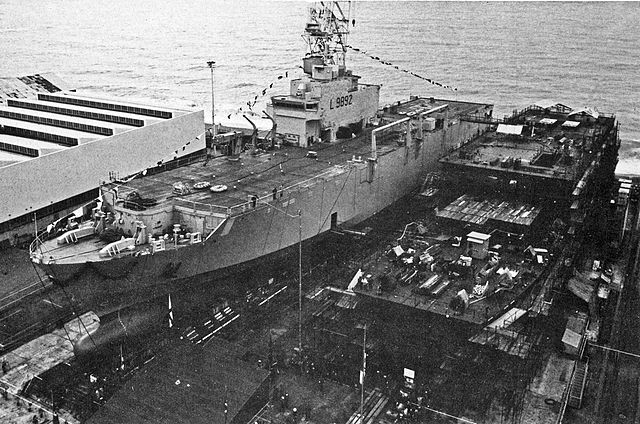
Launch of San Giorgio in 1987
The US showed the new amphibious trend clearly was around LHDs for rapid operations, both projecting smaller landing crafts and landing troops by air assets simultaneously, offering far greater tactical possibilities. The main carrier would stay out of harm inside a fleet protection bubble. Thus in the early 1980s was planned a replacement. The initial specs targets was not for massive US analogue ships of 50,000 tonnes with both an helicopter/VTOL hangar and vehicle hangar plus dock, but a more reasonable 5,000 tonnes vessel keeping its helicopters on flight deck, but without hangar.
The Grado class were indeed pure landing units, and the new vessels because of their deck received a side island and looked like in the first draft as a reduced Garibaldi or Tarawa. Crucially they were called as LPDs, combining the advantages of an AKA (Attack Cargo Ship) and a LSD (Landing Ship Dock), floodable for indirect landing on the beach by intermediary transports, the mothership staying afar from the shore, defending by its escort. These “transport and disembarkation ships” could bot bring assets from port to port if needed, but was mostly tailored for port to shore operations. Specifications also included natural disasters reflief, rescue and assistance operations at home and abroad. It was to intervene to the benefit of a population after a major disaster or intervene in a major pollution episode, and to act as training ship, embarking Naval Academy Officer Cadets for summer educational cruises, which needed a reconfiguration of the main hangar, which needed to stay modular.
The yard’s R&D officers in charge did not started on a blank page and could take advantage in their experience building large commercial ferries. To the base design was added self-defensive light armament, and overall good operational flexibility. The small size and stability constraints meant it could not have an helicopter hangar. Those had to be parked on deck only, and so exposed to the eklements. This was judged acceptable in regard to the intended primary operational theater, the Mediterranean. Thus, the “saints” are not LHDs despite their flight deck.
The design was ready in 1984 and the first ships, immatriculated L 9892, San Giorgio (Patron saint of Milan, Northwest Italy) was ordered to Riva Trigoso Yard (Fincantieri), Sestri Levante, Genoa. She was laid down on May, 27 1985 and her sister San Marco (the patron saint of Venice and Venetia) even earlier on March, 28. San Giusto (Justus of Trieste) was ordered six years later on August, 19, 1991 of a modified design (see later).
Design of the class
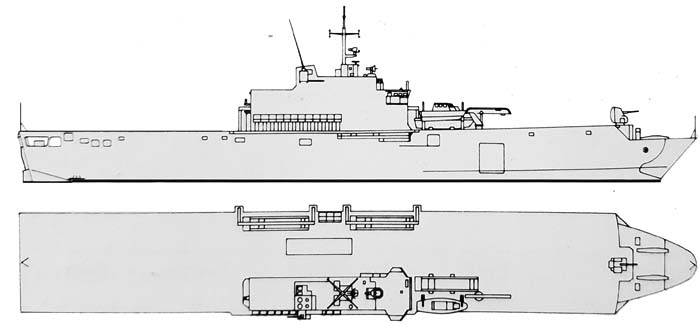
Rendition by Conway’s, San Giorgio initial state in 1988
Hull and general design
The San Giorgio class as rated at 5000 tonnes standard, and 7,960 t (7,830 long tons) fully loaded, but 8,000 t (7,900 long tons) for San Giusto.
They all however have the same size, with a length of 133 m (436 ft) and Beam of 20.5 m (67 ft) and a draught of 5.3 m (17 ft).
Transom stern is necessary for the main dock entry. The middle aft section at waterline level is this tailored as a catamaran, to house landing craft. This is however a small and narrow docj at just 20.5 x 7 m, in which three LCM landing crafts could be stored, three other smaller craft on the main deck. Loading capacity is 1,000 tonnes. Accomodations includes a 99 m³ refrigerated store, 300 m³ dry cargo storage, 60 tonnes of aviation fuel. Normal capacity is 350 equipped infantry, 30 AFVs and softskin vehicles? The ships were tested with the whole range of Italian vehicles in ioperations a the time, such as the VCC-1 IFV and Arisgator or AAV7 amphibious APC (an Italian LVTP-7). The units also have an operating room, medical clinic, dental office, x-ray room, gynecological room and delivery room.
The hull’s continuous deck did not extended to the bow, so to leave space for a bow cannon having sufficient firing arc. The slender bow stem comprises a waterline hydrodynamic bulb while superstructures are a single block integrated the hangar. On the starboard side is located the relatively large, blocky control bridge, with single smokestack and short mast to support the main radar and telecommunications antennae.
The internal hull is divided in to four levels:
- Flight deck and superstructure, which includes the bridge, operations rooms, the flight operations assistance center and official accommodation;
- Corridor deck, main accommodation and living quarters, messes and cabins.
- Main hangar/Garage, modular with a continuous deck from stern to bow and ramps to access the dock aft.
- Lower area, with storages rooms, engine rooms and generators, main galley and refrigeration rooms, air conditioning unit, troop accomodations, and thruster bow room, dock aft.
Powerplant
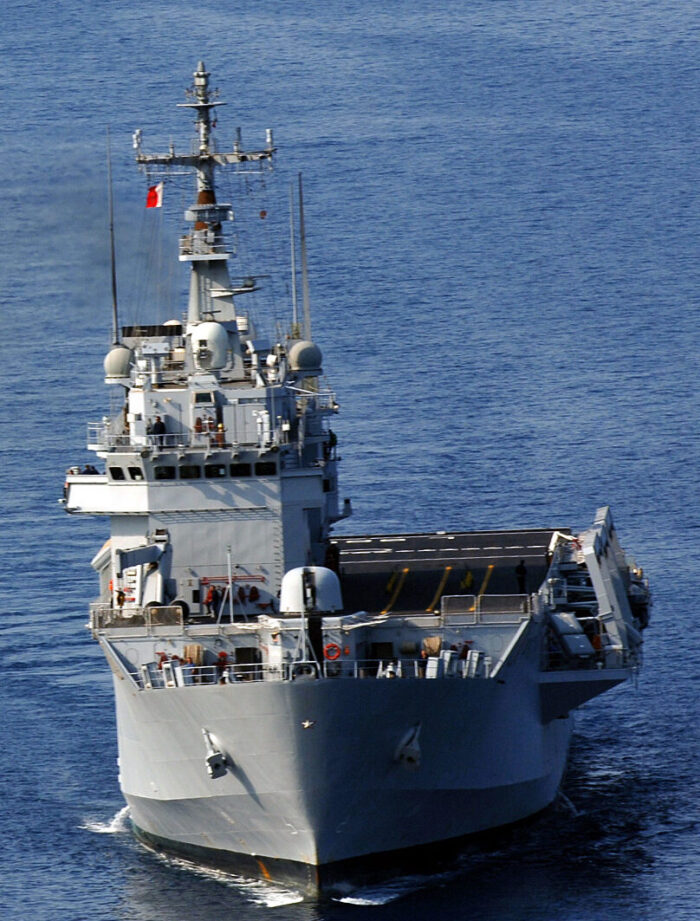
Taranto, Italy (June 24, 2005) Italian exercise command ship ITS San Giusto sails during the North Atlantic Treaty Organization (NATO) submarine escape and rescue exercise Sorbet Royal 2005. Divers from various nations will work together to rescue submariners during the exercise in the Mediterranean. Twenty-seven participating nations, including 14 NATO nations will test their capabilities and interoperability. Four submarines with up to 52 crewmembers aboard will be placed on the bottom of the ocean, while rescue forces with rescue vehicles and systems work together to solve complex disaster rescue problems. U.S. Navy photo by Chief Journalist Dave Fliesen (RELEASED)
The beating hart of “Saints” rests on two, massive 12-Cylinder Grandi Motori Trieste A-420.12 diesels, producing together a total of 16,800 hp (12,353 kW). Each is capable of operating two axles, each coupled to a reduction unit drive. The end shaft then turns a five-bladed variable pitch propeller to provide enough flexibility for port maneuverability and this is compounded by an auxiliary electric thruster with bow propeller, both solutions inspired by civilian ferries.
Top speed is 20 and range approximately 4,500 miles at this top speed, 21 knots (39 km/h; 24 mph) on trials, max, light. The overall range of 7,500 nautical miles (13,900 km; 8,600 mi) is obtained as cruise speed of 16 knots (30 km/h; 18 mph). This is the main advantage of an all-diesel solution combining two diesel engines Grandi Motori Trieste GMT A 420.12, 6,264 kW (8,400 hp) each and four diesel engine generators Grandi Motori Trieste GMT B230.6, 770 kW (1,030 hp) each, the latter are however involved in electric supply, not propulsion:
Electricity is provided by the four GMT B 230.6 groups 770 kW each (450 V, 60 Hz) when the main diesels are cold. The ship comes indeed with a Platform Operations Center, including remote control of the machinery with full automation for the power plant, with screens, gauges and alarms display.
Armament
The armament consisted of a 76/62 mm OTO-Melara anti-aircraft gun, two 20 mm Oerlikon machine guns, two rocket launchers and a Simmel very large smoke projector.
Main: 1985 Oto-breda Super Rapido 76 mm gun
The “super rapido” os a well known, well exported light AA gun also usable against ships and missiles to some extent.
It fires a 6×636mm 6.3 kilograms (14 lb) round with 12.5 kilograms (28 lb) cartridge, 2.35 kilograms (5.2 lb) charge.
The mount can elevate −15°/+85° at 35°/s for 360° at 60°/s, at MV 915 m/s (3,000 ft/s), 120 rpm, 16,000 m. Normal cap. is 80 ready rounds.
It was removed from San Giorgio and San Marco to increase flight deck space.
Secondary: OTO 20mm
Two OTO Melara Oerlikon KBA 25/80 mm guns were installed on the deck. The Oerlikon KBA 25 mm was developed as a succesor to the legendary 20 mm in 1973. They could be instaled on integrated mounts with fast moves, assisted, and far better integrated targeting system.
Specs: 112 kg (247 lb), 2,806 mm (110.5 in), firing the NATO 25×137mm at 100-200 rpm with Dual Feed at MV 1,100 m/s (3,600 ft/s), RA 3,020 m (9,910 ft) to 5,850 m (19,190 ft)
Sensors
Sensors and processing systems comprised the following:
-SMA MM/SPQ 702 search radar
-GEM Elettronica navigation radar: MM/SPN-748 then MM/SPN-753(V)9 and now dual band radar (X/Ka) MM/SPN-760(V)
-Selex ES RTN-10X fire control radar with the Argo NA-10 firing direction system
-Elettronica SpA INS-3 ECM/ESM suite for electronic warfare
-GPS/NAVSTAR navigation system
-NIXIE noise generation system
Carrying capacity
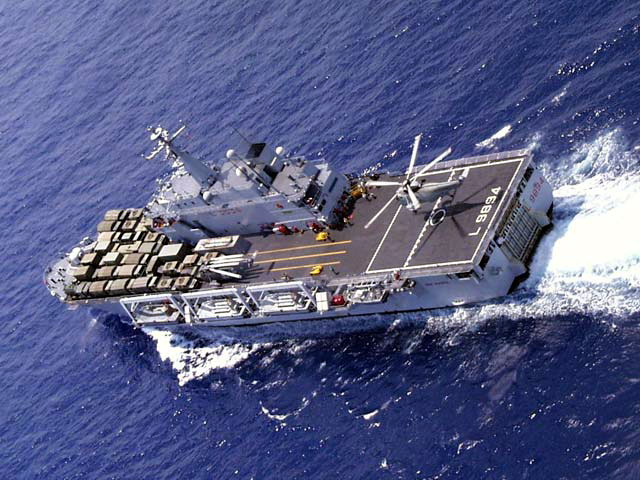
The garage is used for loading and unloading vehicles on both ends through the use of ramps, with a folding stern door, side sliding door starboard, and bow door lifting up. It was eliniminated during modernization.
At the extreme stern, below the waterline is located the flooded dock, to house a single 18.50 m long landing crafts with two other MTMs harnessed on special saddles on the flight deck. The dock threshold is below the waterline so it is flooded by just opening its stern door, and dried up door closed, of flooded door close using seacocks. The connection between the dock and comprises a large ramp area called the “beach”, for direct loading of a vehicle on board the LCT, stern turn to the dock door. The dock could also be used as extra vehicle loading area. Via the side doors and loaded generally the palettized storage and ammunition. This level also hosts the hydraulic power units, service rooms, laundry, boatswain’s room and secretariats.
A fast motorboat for VIP transport operated by crane is located forward of the island.
Air Group
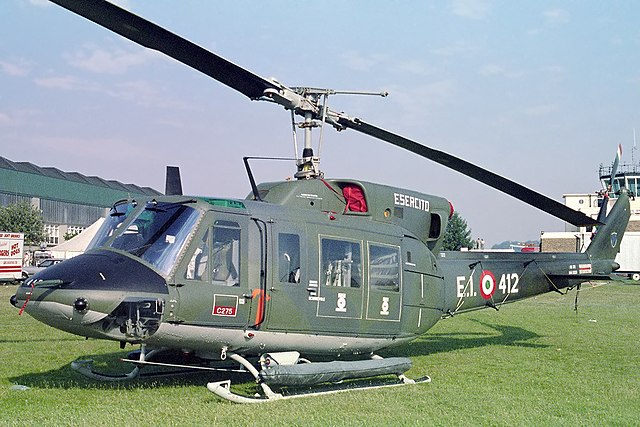
AW-212 of the Army
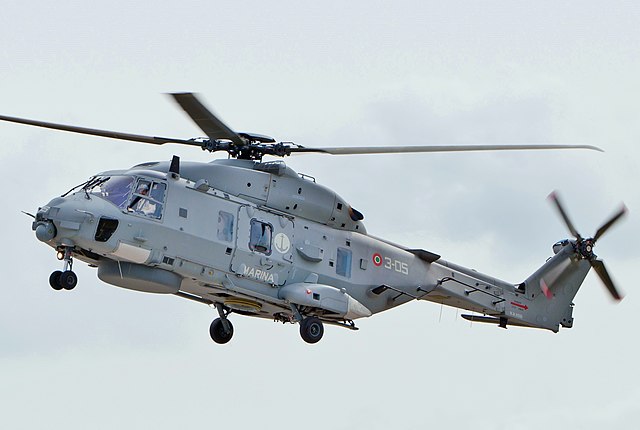
NH-90A of the Marina
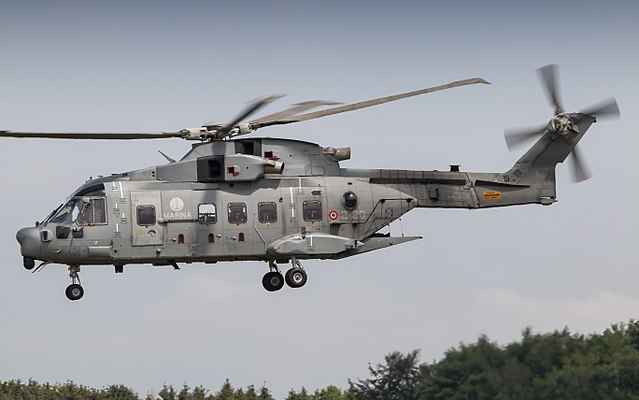
EW-101 of the Marina
Her flight deck is limited due to the large island and lacement of the two landing crafts on deck edges, and it is divided into two areas: The bow area, approximately 800 m², for parking and another aft area of approximately 900 m² for take-off and landing, with four spots, landing lights, and a luminous path for night operations.
Aircraft carried were usually either three AW-101 and five Agusta Bell AB-212 helicopters or SH90A. The ship could resupply and refill them in operations, including avgas and supplies, armament, that can be mounted via the lift on the port side of the island on deck, narrow, but still ling and large enough to carry down the hangar any helicopter on deck if needed.
⚙ specifications |
|
| Displacement | 7,960 t (7,830 long tons) FL, 8,000 t San Giusto |
| Dimensions | 133 x 20.5 x 5.3m (436 x 67 x 17 ft) |
| Propulsion | 2× diesel Grandi GMT A420.12, 6,264 kW (8,400 hp), 4x diesel generators Grandi GMT B230.6 770 kW (1,030 hp) |
| Speed | 21 knots (39 km/h; 24 mph) |
| Range | 7,500 nautical miles (13,900 km; 8,600 mi) at 16 knots (30 km/h; 18 mph) |
| Armament | 1x Otobreda 76 mm, 2× OTO Melara Oerlikon KBA 25/80 mm |
| Sensors | SMA MM/SPQ 702 SR, GEM Elettronica NR, Selex ES RTN-10X FCR, INS-3 ECM/ESM |
| Ship Capacity | 3× LCM62-class LCM or MTP96-class LCVP, or 1 patrol craft |
| Troop Capacity | 350 troops/30 medium tanks/36 AFVs |
| Air Group | 3× AW-101/5× Agusta Bell AB-212/SH90A |
| Crew | 17 officers, 163 ratings |
 San Giorgio
San Giorgio
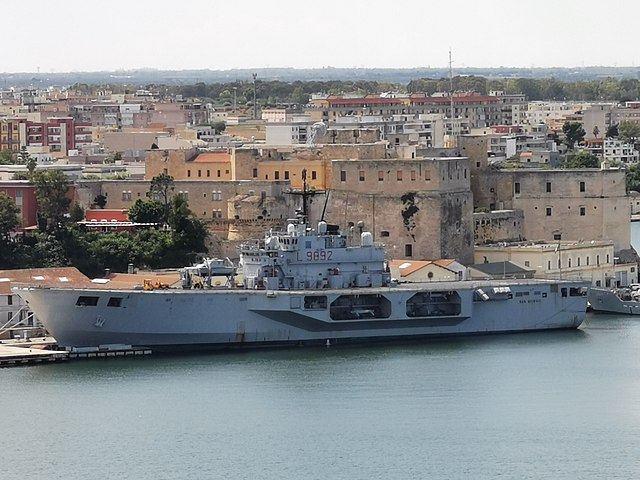
San Giorgio in Brindisi
First built at Fincantieri, Riva Trigoso shipyard and officially launched on 21 February 1987, she had to wait until the 25th to sail to her outfitting site due to bad weather, and was commissioned on 13 February 1988.
Previous San Giorgio ships were the 1908 armored cruiser taking part in theItalian-Turkish War and WWI, srill modernized and used in the interwar for Naval Academy of Livorno cadets, Libyan Naval Command in Tobruk, scuttled on 21 January 1941. Post-WW2, the former light cruiser Pompeo Magno was renamed San Giorgio and completely rebuilt as modern AA escort destroyer, re-entering service in 1956. TS 1963-1965 again for the Naval Academy of Livorno until 1980.
1989-2006 saw San Giorgio involved in a serie of exercises and training cadets of the Livorno Academy.
In mid-2006, the Marina Militare despatched San Giorgio in the Lebanon War, Operation Mimosa 06 and Operation Leonte with all three sisters, San Giusto, San Marco and San Giorgio escorted by Aliseo, Luigi Durand de la Penne and the aircraft carrier Giuseppe Garibaldi. The ships landed in Beirut port, controlled by the 1st San Marco Regiment, and were landed tons of material intended for the population, like field kitchens, ambulances and electric generators as well as pneumatic tents, medicines and food distributed to the non-combatant civilian population via control of the Ministry of Foreign Affairs and Civil Protection personal as well as the Italian Red Cross and UN World Food Program representatives.
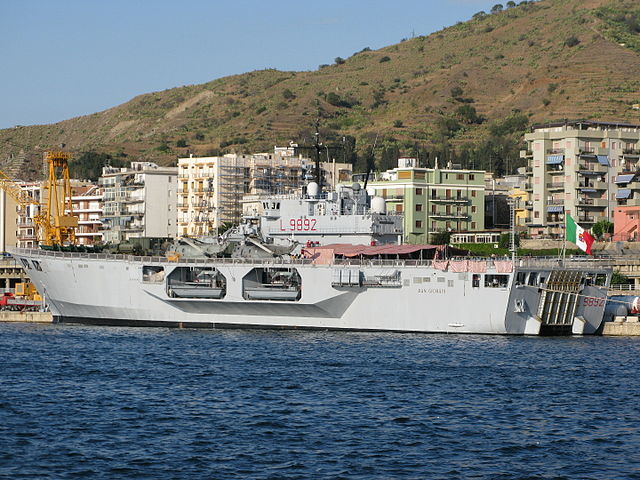
In Reggio di Calabria 2008
In December 2014, she took part search and rescue operations for the Norman Atlantic, which was successful. On 3 August 2016, she patrolled against smugglers and human traffickers and was tasked to train the Libyan Coast Guard, Navy and enforce the arms embargo according to UN resolutions during the civil war. Libyan cadets and officers were trained onboard San Giorgio from September.
Rear Admiral Frumento replaced his Greek counterpart Theodoros Mikropoulos at the head of this operation by October 19, 2020, still aboard San Giorgio as flagship.
 San Marco
San Marco
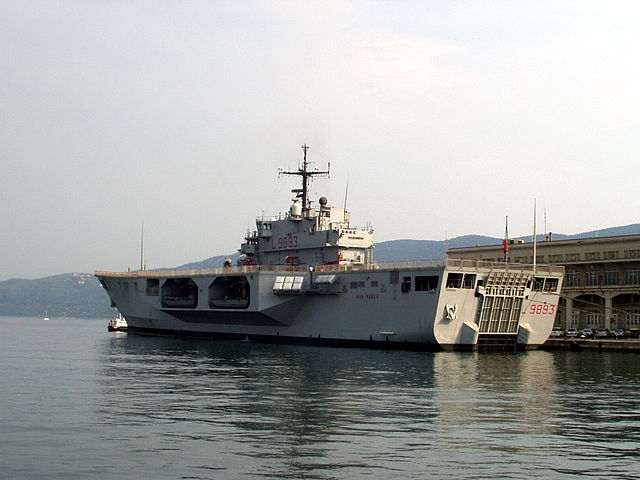
Delivered on 14 May 1988 and unlike her sister ship, San Marco main tasks were humanitarian rescue operations as well as home Civil Protection, for which she was outfitted with a larger, more complete hospital, greater capacity to produce drinking water and sets of equipments for anti-pollution operations, notably with tanks filled with biodegradable solvents and rubber barriers.
From December 1992 San Giorgio, San Marco carried San Marco Battalion in Somalia (Ibis I and Ibis II missions), escorted by the 24th Naval Group (Vittorio Veneto, Vesuvius and Grecale) and 25th Naval Group (Giuseppe Garibaldi, Stromboli and Scirocco).
By the summer of 2006, the Italian Navy was one of the first involved in the Lebanon War and during Operation Mimosa 06 and Operation Leonte all three sisters were dispatched. San Marco, given her facilities, was particularly handy in humanitarian operations there (see above) with a matrial, food and water distribution in the port (plus providing electricity), secured by the 1st San Marco Regiment.
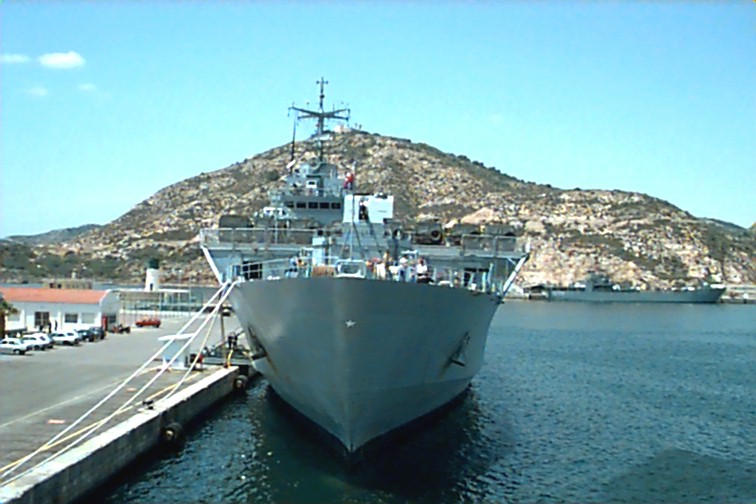
On 16 June 2016, San Marco sailed with Bersagliere, Cigala Fulgosi, Andrea Doria, Carlo Margottini, Etna and Stromboli in the “Flotta Verde” exercise (Great Green Fleet initiative) with the USS Dwight D. Eisenhower, USS San Jacinto and USS Roosevelt.
Records awaited for 2016-2024.
 San Giusto
San Giusto

Unlike her sisters, San Giusto, commissioned on 14 April 1994 as to be mainly used as training ship with large spaces and accommodations for officer students and non-commissioned officers.
She had teaching and specialist equipment, workshops and schoolrooms. She trained 2nd year students from the Naval Academy of Livorno, replacing Montecuccoli, San Giorgio and Duilio in this role.
Operational activity comprised training sessions abnd cruises, fleet exercizes, NATO cooperation exercises.
In 1999, this routine was interrupted by East Timor crisis, as she transported COMSUBIN commandos to the island. In 2002 she carried out a training cruise in Northern European waters from 5 July to 29 September ovber 10,887 miles, taking part in the 750th Anniversary of Stockholm and 125th Anniversary of Bremerhaven.
In 2004, after a Western Mediterranean-Eastern Atlantic training cruise from 30 May to 10 July (1st class students) and from 18 July to 26 September she carried the Academy 2nd class in Northern European waters again.
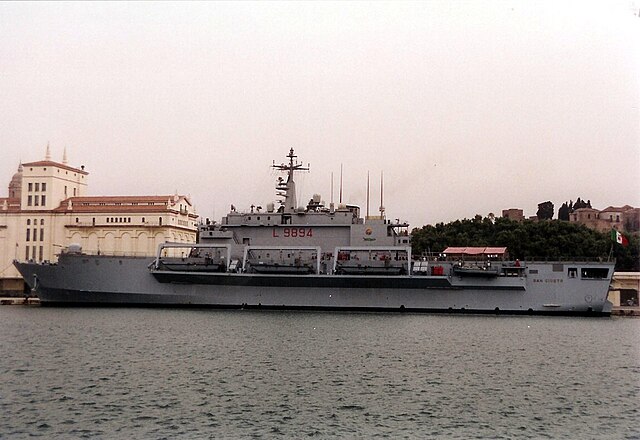
The 2005 training campaign was again in the Mediterranean, and this time foreign 12 officer cadets were invited. By the summer of 2006 she was in the Eastern Mediterranean then soon engaged in the Lebanon operation Leonte together with her sisters and the Garibaldi. She also took part in Operation Antica Babilonia.
The summer of 2010 saw a training cruise with the Naval Academy of Livorno students to North American waters, she also took part in an exercise with the USN.
In the summer of 2011 she became tje HQ ships for the Operation “Unified Protector”, the NATO intervention in Libya.
 Kaalit Beni Abbes (2013)
Kaalit Beni Abbes (2013)
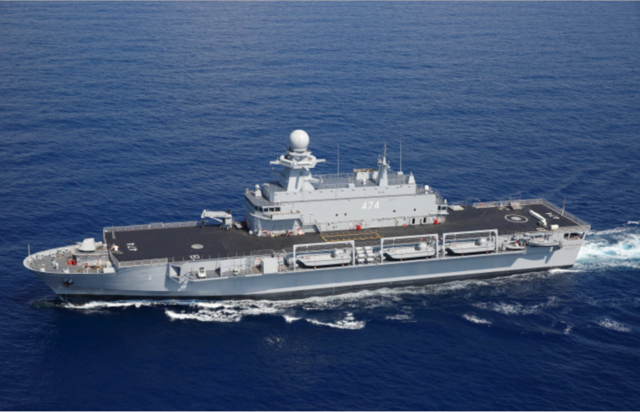
The “Bâtiment de Débarquement et de Soutien Logistique” was called in general fleet catalogue (such as in Janes) “San Giorgio Improved”: Delivered on 4 September 2014, comm. on 28 March 2015 as Kalaat Béni Abbès (474) it had differences like updated electronics. Under the acronym BDSL and Launched on 8 January 2014 it had Aster 15 self defence SAM located behind the island superstructure, and still kept an OTO Melara 76 mm “Super Rapido” at the bow, but two 25 mm RWS. Capacity was not very different with three landing craft mechanized (LCM), three small landing craft vehicle personnel (LCVP), or one large landing craft personnel (LCP), plus two semi-rigid boats. The hangar is large enough for 15 armoured vehicles, 440 soldiers for a crew of 150.
 Al Fulk (2023)
Al Fulk (2023)
In 2016 the Qatari Navy ordered a further improved model launched at Palermo shipyards on 24 January 2023 (“Al Fulk”), showing there as still room for improvements on relatively light, small LHDs compared to the massive US vessels on the international Market. They are indeed significantly smaller, cheaper than the French Mistral or Spanish Juan Carlos, which represented the other side of the spectrum on an European Offer.
Upgrades & Replacement
Between 1999 and 2000, San Giorgio and San Marco underwent changes such as the removal of their 76mm MMI cannon, housing was installed on the left and two LCVPs were relocated on the edges of the flight deck. The flight deck was extended thus, from bow to stern to operate four helicopterssimultaneously. The bow door was eliminated, the lift kept but the 100 x 20.5m hangar was only used for vehicles.
The third ship, San Giusto, was created as a slightly different project. Alshtough coming also from Fincantieri and entering service in 1994 she had a more powerful engine, with new diesels and a flight deck 3/4 smaller. The bridge was differe and the bow 76/62mm Super Rapido is maintained to increases her defensive capabilities, making her a better training ship.
Evolution
The first pair is scheduled for replacement, Starting from 2024, by the new LHD “Trieste”, planned to comprise three units total in order to replace the San Giorgio class at the 2030 treshold. They were left at the discretion of the 2018 Defense Budget. The go-ahead was received to procure two 16,500-ton amphibious assault ships and according to the Italian MoD Planning (Documento Programmatico Pluriennale della Difesa) FY2023-2025 the new Trieste class are to be able to carry two LC-23 heavy landing craft and a larger flight deck with more helicopter spots, a mmore extensive hangar and extended personnel accommodation facilities (large hospital, greater storage for humaniarian missions, a mobile energy supply unit, ect…). Contract was signed in 2024 for a delivery expected to replace all three in 2028-2030.
Read More/Src
Books
Bishop, Chris; Chris Chant (2004). Aircraft Carriers. London: Summertime Publishing Ltd. p. 223.
Conways all the world’s fighting ships 1947-95
Links
https://www.naval-technology.com/projects/san_giorgio/
https://www.betasom.it/forum/index.php?/topic/37772-la-marina-militare-italiana-dal-1981-al-1990/page/4/
https://www.marina.difesa.it/noi-siamo-la-marina/mezzi/forze-navali/Pagine/SanGiusto.aspx
https://en.wikipedia.org/wiki/San_Giorgio-class_amphibious_transport_dock
https://it.wikipedia.org/wiki/Classe_San_Giorgio_(nave_da_sbarco)
https://www.ilsole24ore.com/art/fincantieri-varata-palermo-l-unita-anfibia-il-qatar-AEKIUcZC
https://www.upi.com/Business_News/Security-Industry/2011/08/02/Algerian-navy-orders-vessel-from-Italy/UPI-34201312308517/
Fincantieri imposta nei cantieri di Palermo la LPD per la Marina del Qatar
https://www.fincantieri.com/en/products-and-services/naval-vessels/kalaat-beni-abbes/
https://marineschepen.nl/nieuws/Amfibisch-transportschip-Qatar-te-water-gelaten-270123.html
https://commons.wikimedia.org/wiki/Category:San_Giorgio_class_LPD

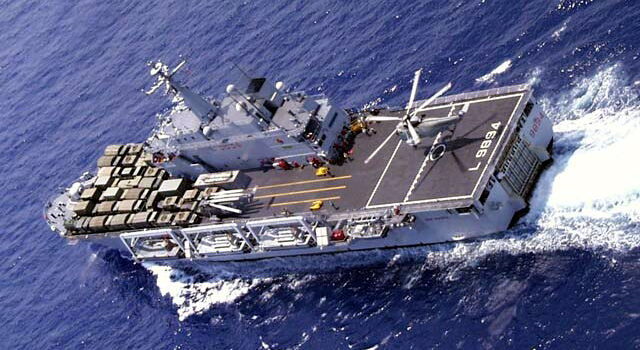
 Latest Facebook Entry -
Latest Facebook Entry -  X(Tweeter) Naval Encyclopedia's deck archive
X(Tweeter) Naval Encyclopedia's deck archive Instagram (@navalencyc)
Instagram (@navalencyc)





 Austrian Navy
Austrian Navy French Navy
French Navy Royal Navy
Royal Navy Armada Espanola
Armada Espanola K.u.K. Kriegsmarine
K.u.K. Kriegsmarine Dansk Marine
Dansk Marine Nautiko Hellenon
Nautiko Hellenon Koninklije Marine 1870
Koninklije Marine 1870 Marinha do Brasil
Marinha do Brasil Osmanlı Donanması
Osmanlı Donanması Marina Do Peru
Marina Do Peru Marinha do Portugal
Marinha do Portugal Regia Marina 1870
Regia Marina 1870 Nihhon Kaigun 1870
Nihhon Kaigun 1870 Preußische Marine 1870
Preußische Marine 1870 Russkiy Flot 1870
Russkiy Flot 1870 Svenska marinen
Svenska marinen Søværnet
Søværnet Union Navy
Union Navy Confederate Navy
Confederate Navy Armada de Argentina
Armada de Argentina Imperial Chinese Navy
Imperial Chinese Navy Marinha do Portugal
Marinha do Portugal Mexico
Mexico Kaiserliche Marine
Kaiserliche Marine 1898 US Navy
1898 US Navy Russkiy Flot
Russkiy Flot French Naval Aviation
French Naval Aviation Russian Naval Aviation
Russian Naval Aviation Sovietskiy Flot
Sovietskiy Flot Royal Canadian Navy
Royal Canadian Navy Royal Australian Navy
Royal Australian Navy RNZN Fleet
RNZN Fleet Chinese Navy 1937
Chinese Navy 1937 Kriegsmarine
Kriegsmarine Chilean Navy
Chilean Navy Danish Navy
Danish Navy Finnish Navy
Finnish Navy Hellenic Navy
Hellenic Navy Polish Navy
Polish Navy Romanian Navy
Romanian Navy Turkish Navy
Turkish Navy Royal Yugoslav Navy
Royal Yugoslav Navy Royal Thai Navy
Royal Thai Navy Minor Navies
Minor Navies Albania
Albania Austria
Austria Belgium
Belgium Columbia
Columbia Costa Rica
Costa Rica Cuba
Cuba Czechoslovakia
Czechoslovakia Dominican Republic
Dominican Republic Haiti
Haiti Hungary
Hungary Honduras
Honduras Estonia
Estonia Iceland
Iceland Eire
Eire Equador
Equador Iran
Iran Iraq
Iraq Latvia
Latvia Liberia
Liberia Lithuania
Lithuania Mandchukuo
Mandchukuo Morocco
Morocco Nicaragua
Nicaragua Persia
Persia San Salvador
San Salvador Sarawak
Sarawak Uruguay
Uruguay Venezuela
Venezuela Zanzibar
Zanzibar Warsaw Pact Navies
Warsaw Pact Navies Bulgaria
Bulgaria Hungary
Hungary

 Bundesmarine
Bundesmarine Dutch Navy
Dutch Navy Hellenic Navy
Hellenic Navy Marina Militare
Marina Militare Taiwanese Navy
Taiwanese Navy Chinese Navy
Chinese Navy Indian Navy
Indian Navy Indonesian Navy
Indonesian Navy JMSDF
JMSDF North Korean Navy
North Korean Navy Philippines Navy
Philippines Navy ROKN
ROKN IDF Navy
IDF Navy Royal New Zealand Navy
Royal New Zealand Navy Egyptian Navy
Egyptian Navy South African Navy
South African Navy

































 RN
RN
 Marine Nationale
Marine Nationale
 Soviet Navy
Soviet Navy
 dbodesign
dbodesign